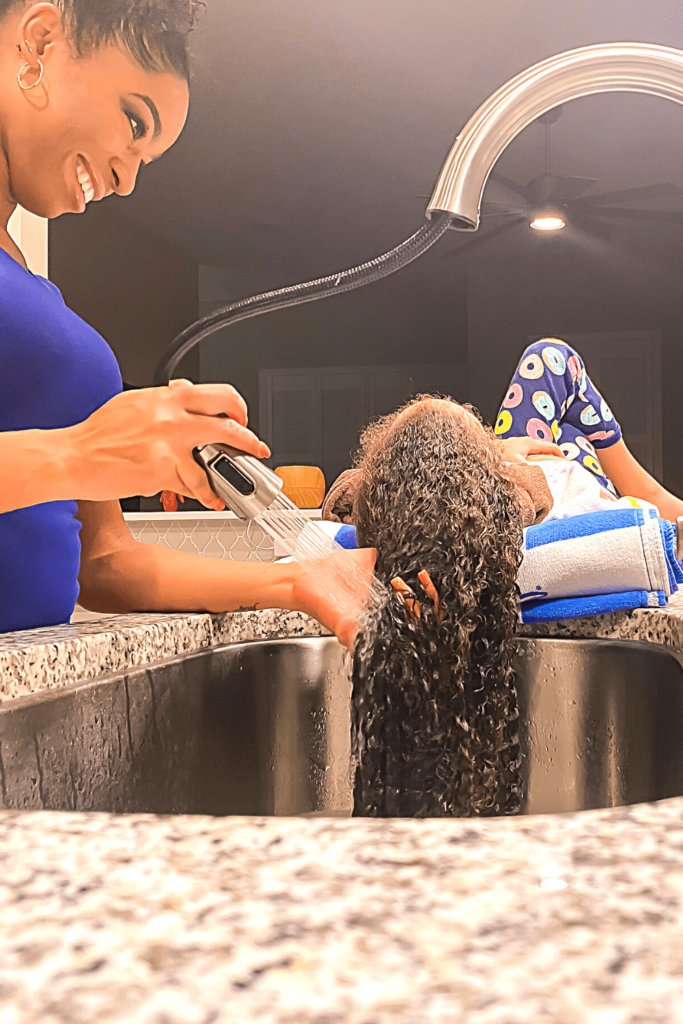You see “biracial hair” in search results on YouTube, but you’re really searching for curly hair tutorials.
Maybe you’re the parent of a biracial child, but none of the tutorials on Pinterest look like your child.
Or maybe, you’re just struggling to understand curly hair altogether.
As the mother of three biracial children (all with different curl patterns), I’ve used, searched, and made my own tutorials about biracial hair.
But, apparently, the term is fueling debated in the curly hair community.
This post is all about what makes biracial hair so offensive.

The natural hair community originates from the civil rights movement in America.
It comes from African Americans’ battle for equality in American society.
Over time it has grown to be a huge platform for many different identities of people.
It seeks to support all textured hair types that might face racism and prejudice in America today.
The term biracial hair can be offensive because it poses a divide within the natural hair community.
It serves to steal away from the deeply meaningful roots of the natural hair movement in America.
Natural hair comes in so many different shapes, sizes, and textures that there is no need to separate the natural hair community and people who identify as biracial or multi-racial.
Biracial Hair vs the Natural Hair Community
The natural hair movement originates from the black community’s battle for pride in their naturally textured tresses.
The natural hair movement was actually birthed long before the early 2000s, as many people currently believe.
During the civil rights movement, black women fought for their right to wear their natural hair despite the discrimination and ridicule that often came along with it.
For a long time, America used hair as yet another way to differentiate and discriminate against African American men and women.
As a result, in the early 60s, the black community started using their hair to symbolize pride in their identities and cultures.
This pride is part of what led to the staple big Afro hairstyle of the 70s.
In the early 2000s, the natural hair movement was sparked once again.

Reclaiming African-American History
Black women felt a need to reclaim their beautifully textured hair.
Living within a society that constantly puts African American men and women under scrutiny takes a toll on a person’s identity.
As a result of largely European beauty standards, many black women were subject to manipulating their hair in some way.
They often did this by chemically altering their natural hair texture, using excessive heat to style and manipulate their hair, or even covering it with more socially acceptable wigs.
This was all done to appear more appealing to society and seemingly professional environments dominated by European beauty standards.

So, What Does ‘Biracial Hair’ Even Mean?
When it comes to the natural hair community, it’s all about embracing curly, kinky, coily hair textures that are often viewed as undesirable.
This is all-inclusive for anyone who might identify as biracial or multi-racial and have hair textures that fall into the natural hair category.
The issue is when you realize that biracial hair is not a monolith.
This means that many different racial identities fall into the category of biracial hair.
Someone who identifies as African American and Hispanic is NOT going to have the same hair as someone who identifies as African American and Caucasian.
They will both, however, fall under the category of biracial.
This would mean that a single category of biracial hair does not exist.
In fact, it’s a term that simply takes away from natural hair movement and all that it stands for.

This post was all about biracial hair.
Using the term biracial hair is upsetting for the natural hair community because it implies division where it is unnecessary.
While the natural hair movement originated from African American men and women, it has become a platform for many textured hair types to stand on.
The natural hair community does encompass biracial hair, but biracial hair does not encompass the whole natural hair community.
As a result, the term biracial hair begins to take away from the origins of the natural hair movement in America.
It’s a term that only serves to divide rather than unify and uplift the natural hair community as it exists today.
. . .
If you found this post helpful (or you have a house full of kids with mixed curly hair), make sure to check my other posts below about mixed hair care and the best way to care for your child’s natural hair.
If you also have kids with opposite hair types, click here to read more and join us on Instagram to catch us in real-time as we live out our daily Do You Even Mom moments.
[This post has affiliate links, but all opinions are my own. Read my full affiliate link disclosure here.]
Other posts you may like:
- Best Curly Hair Products for Biracial Boys (That Don’t Smell Girly)
- The Best Curly Hair Products at Target
- 9 Amazing Brushes You Need For Your Child’s Mixed Hair
